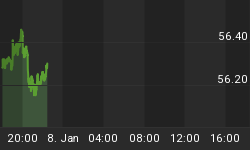I get this question a lot: "Should I buy gold now, or wait for a pullback?"
It's a valid question. For nearly two years, gold hasn't had a serious decline. There have been pullbacks, of course, but nothing assumption-challenging. In fact, since October 2008, gold's largest price drop is 10.6% (based on London PM fix prices), and yet the average of all declines since 2001 is 13% (of those greater than 5%). The biggest pullback we've seen this summer is 8.2%. Technically the summer's not over, but I'll admit I'm surprised we haven't had a better buying opportunity.
So, is now the time to buy? It depends on your honest answer to another question: "Do you own enough gold?" By "enough" I mean an amount that lends meaningful protection on your assets. By "meaningful" I mean that no matter what happens next - another financial blow-up, accelerating inflation, crushing deflation, war, a plummeting dollar, more reckless government spending - you won't worry about your investments.
Whether you should buy now is almost irrelevant if you don't already own a meaningful amount of gold. If you earn $50,000 a year, how is one gold Eagle coin going to protect you if the dollar plummets and sends inflation soaring? If your investable assets total $100,000, is your nest egg sufficiently protected owning two gold Maple Leafs? This is all akin to buying a $50,000 insurance policy for a $500,000 home.
Today we face the prospect of prolonged economic stagnation, and most governments are administering grossly abusive monetary policy as a remedy. While some of the consequences are already being felt, the full ramifications have not hit your wallet yet. But they will.
If you don't have at least 10% of your investable assets in physical gold, or at least two months of living expenses, you have your answer: Buy. Don't use leverage, don't borrow money, and don't buy with reckless abandon, but yes, get your asset insurance policy and tuck it away. And then start working toward 20% (we recommend a third of assets be in various forms of gold in Casey's Gold & Resource Report).
Back to the original question: should we buy now, or wait for a pullback?
The answer comes when you look at the big picture. If you pull up a 9-year chart of gold, what sticks out is that the price is near its all-time nominal high. One could be forgiven for thinking it looks toppy or at least ripe for a pullback. But I assert that the highs for gold have yet to be charted.
What will a gold chart look like after adding five years to it?
When projecting gold's potential price peak, there are many ways to measure it. Conservatively, gold reaching its inflation-adjusted 1980 high would have it topping around $2,400 an ounce. More radically, if the U.S. tried to cover its cumulative foreign trade deficit with its current gold holdings, gold would need to hit about $32,000/oz.
Let's take something more middle of the road, and apply the same trough-to-peak percentage advance gold underwent in the 1970s. (I think there's a greater than 50/50 chance it does more than that, given the precarious nature of the U.S. dollar.) Gold rose from $35 in 1970 to $850 in 1980, a factor of 24.28. Our price bottomed in 2001 at $255.95; multiply that by 24.28 and you get a gold price of $6,214 per ounce.
Sound too high? Well, would it feel high if you had to pay $12.50 for a Big Mac? At $3.39 today at my local McDonald's, that's about what it would cost ten years from now if we get the same rate of inflation we had in the late 1970s.
So if gold hits $6,214, what might it look like on a chart if you bought today around $1,200?

$1,200 doesn't seem so pricey, does it?
I'm not saying there won't be pullbacks or that you shouldn't try to buy at lower prices. Just keep a big-picture perspective. Let's say gold falls to $1,100 and you're kicking yourself for having bought at $1,200... if gold reaches $6,200 an ounce, the profit difference between buying at $1,200 and buying at $1,100 is only 1.6%. If gold gets whacked to $1,000 (at which point I'll be buying with both hands) the difference is still only 3.2%.
Heck, even if gold peaks at $2,400, you still get a double from current levels. (But unless government monetary policies immediately reverse course, gold isn't stopping at $2,400.)
So there's my answer. Yes, you have to accept my projection of gold's ultimate price plateau. And you have to sell at some point to realize the profit. But if the final chapter of this bull market looks anything like the chart above, I don't think you'll be too upset having bought at $1,200.
Carpe gold.
As high as we think gold could go, it's gold producers that will gain three and four times more, bringing us potentially life-changing profits. Check out the new issue of Casey's Gold & Resource Report, where we've identified the easiest and cheapest way to buy gold stocks, even for smaller wallets. It's only $39 per year - try it risk-free here.
















